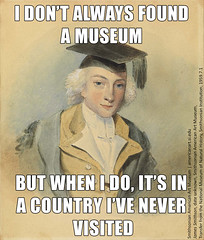origins of the smithsonian
December 21, 2013
 In 1826, James Smithson wrote in his will that, if his heir were to die without children, his entire estate would go “to the United States of America, to found at Washington, under the name the Smithsonian Institution, an Establishment for the increase and diffusion of knowledge among men.” This unusual bequest was even more strange in that James Smithson has never been to the United States of America in his lifetime.
In 1826, James Smithson wrote in his will that, if his heir were to die without children, his entire estate would go “to the United States of America, to found at Washington, under the name the Smithsonian Institution, an Establishment for the increase and diffusion of knowledge among men.” This unusual bequest was even more strange in that James Smithson has never been to the United States of America in his lifetime.
At the time, President Andrew Jackson didn’t feel that accepting this bequest was within the powers of the executive branch, so it was up to Congress to decided what to do. There were great debates on how to interpret this strange bequest. Should it be dedicated to our scientific knowledge? to understanding our world through the arts? should this institution be the keeper of history? or even create an observatory to look out at the stars and understand our universe? Finally in an Act of Congress on July 1, 1836, the Smithsonian Institution was founded to do all of those things.
In my first few of working at the Smithsonian, I toured the Smithsonian Institution Archives where I saw this hand-written will:

 I learned more about about Smithsonian history on a tour of the “Castle” with curator Rick Stamm, author of an illustrated history of the Smithsonian Institution Building.
I learned more about about Smithsonian history on a tour of the “Castle” with curator Rick Stamm, author of an illustrated history of the Smithsonian Institution Building.
We don’t know exactly why James Smithson made this strange bequest, but it was in an age when our understanding of the world was changing. Smithson had been born in Paris, as the illegitimate son of first Duke of Northumberland. In The Lost World of James Smithson, Heather Ewing notes, that due to the circumstances of his birth, Brittish law declared that he
shall not be hereby Enabled to be of the Privy council or a Member of either the house of Parliament or to take any Office or place of Trust either Civil or Military or to have any Grant of Lands, Tenements or Hereditaments any inheritable property from the Crown to him or to any Person or Persons In trust for him.”
p. 46
However, he still was able to attend Oxford and became a citizen scientist of his day, distinguishing himself as a chemist. He joined several phillosopher’s clubs — gatherings of young men who would discuss theories of the new science. Reading about this history makes me wonder if tech meetups are the modern day equivalent, where men and women gather to exchange ideas and evaluate the latest inventions and discoveries. It strikes me that James Smithson must have seen America as a place where a new institution could thrive, dedicated to the increase and diffusion of knowledge, rather than simply promoting the progeny of the privileged.
James Smithson, of course, was quite privileged, but perhaps his own struggles for recognition provided some perspective that caused him to strive for a higher ideal. Or perhaps he just wanted to make sure that the Brittish crown was never able to seize his assets, even after death. In any case, he left his fortune to our country almost 200 years ago, and the folks at the Smithsonian take its mission quite seriously.
To this day, the Smithsonian museums have no admission cost and are free to the public. Its archives, libraries, research institutes and observatory offer scientists and researchers, facilities and unparalleled historic collections that enable new discoveries every day.